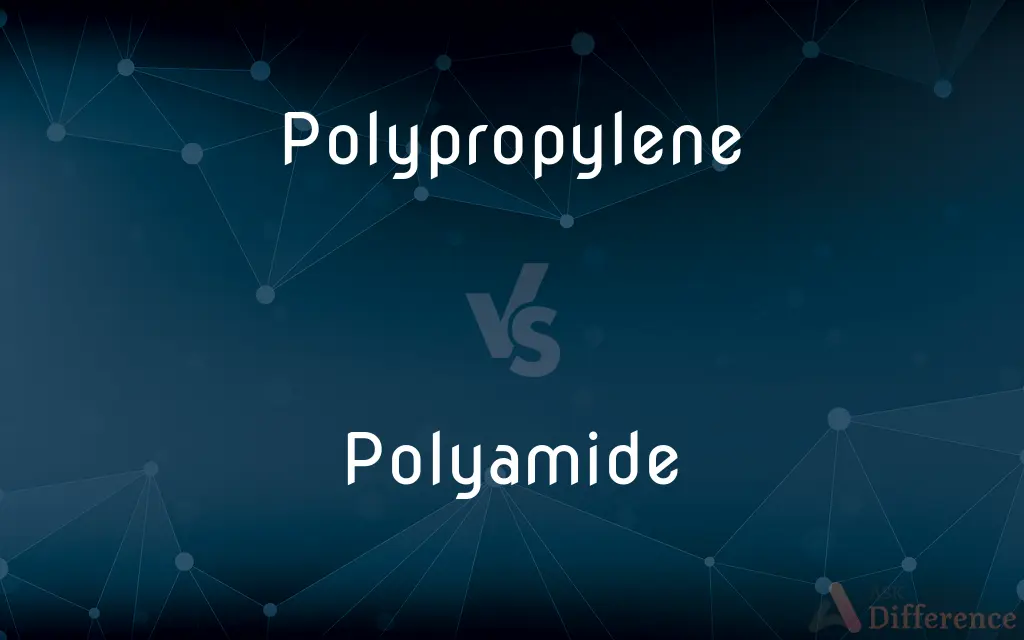Polypropylene vs. Polyamide — What's the Difference?
By Tayyaba Rehman & Urooj Arif — Updated on February 26, 2024
Polypropylene is a lightweight, chemical-resistant plastic used in packaging and textiles, while polyamide (nylon) is known for its strength, elasticity, and use in automotive parts and apparel.

Difference Between Polypropylene and Polyamide
Table of Contents
ADVERTISEMENT
Key Differences
Polypropylene (PP) is a thermoplastic polymer used widely in the production of packaging, labels, textiles, and various types of containers. Its key characteristics include its resistance to chemical solvents, bases, and acids, as well as its fatigue resistance. Polyamides (PA), commonly known as nylons, are another family of polymers, celebrated for their strength, thermal resistance, and excellent wear properties. They are extensively used in the automotive industry, clothing, and as fibers in ropes and threads.
PP stands out for its lightweight nature and is often chosen for applications where weight saving is critical. It also has a lower density compared to most other plastics, making it a preferred choice for lightweight and buoyant applications. On the other hand, polyamides offer superior strength and durability, making them ideal for high-stress applications such as gears, bearings, and automotive components.
Environmental resistance, polypropylene has a good resistance to environmental degradation and acts very well against staining, making it ideal for both indoor and outdoor applications. Polyamides, however, excel in their ability to withstand wear and abrasion, along with having a higher resistance to heat compared to PP, making them suitable for applications that require exposure to high temperatures.
When it comes to water absorption, polypropylene exhibits low water absorption, maintaining its physical properties when exposed to moisture. Polyamides absorb more water, which can result in changes to their mechanical properties, but this characteristic also contributes to the self-lubricating properties of certain types of polyamides, beneficial in specific applications.
The choice between polypropylene and polyamide often depends on the specific requirements of the application, such as the need for durability, chemical resistance, or the ability to withstand high temperatures. Each material has its unique set of properties that make it suitable for various applications across different industries.
ADVERTISEMENT
Comparison Chart
Density
Lower, contributing to its lightweight
Higher, contributing to strength and durability
Chemical Resistance
High resistance to chemicals
Good resistance, but varies by type of polyamide
Thermal Resistance
Lower compared to polyamides
Higher, suitable for high-temperature applications
Water Absorption
Low, maintains properties in moisture
Higher, can affect mechanical properties but beneficial for self-lubrication
Typical Applications
Packaging, textiles, containers
Automotive parts, apparel, gears, bearings
Compare with Definitions
Polypropylene
A durable, chemical-resistant plastic used widely in packaging.
Water bottles are often made from polypropylene.
Polyamide
Exhibits high thermal resistance, suitable for high-temperature areas.
Polyamide parts are used in the under-hood automotive applications.
Polypropylene
Lightweight and used in various textiles and fabrics.
Polypropylene is used in non-woven bags for its strength and lightweight.
Polyamide
Absorbs more water, which can affect its mechanical properties.
Polyamide gears require consideration for humidity in their application.
Polypropylene
Exhibits low water absorption, suitable for outdoor applications.
Outdoor furniture often incorporates polypropylene to withstand weather conditions.
Polyamide
Offers high strength and elasticity, widely used in automotive parts.
Engine covers are commonly manufactured from polyamide for durability.
Polypropylene
Commonly used in medical devices due to its sterilization compatibility.
Syringes are frequently made with polypropylene for safety and hygiene.
Polyamide
Used in ropes and threads for its excellent wear properties.
Climbing ropes are made from polyamide for strength and safety.
Polypropylene
Known for its fatigue resistance, ideal for reusable containers.
Tupperware products utilize polypropylene for its durability.
Polyamide
Known as nylon, used in a variety of apparel for its flexibility.
Nylon stockings are valued for their elasticity and tear resistance.
Polypropylene
Polypropylene (PP), also known as polypropene, is a thermoplastic polymer used in a wide variety of applications. It is produced via chain-growth polymerization from the monomer propylene.
Polyamide
A polyamide is a polymer with repeating units linked by amide bonds.Polyamides occur both naturally and artificially. Examples of naturally occurring polyamides are proteins, such as wool and silk.
Polypropylene
A synthetic resin which is a polymer of propylene, used chiefly for films, fibres, or moulding materials
High-impact polypropylene
Polypropylene underwear
Polyamide
A synthetic polymer of a type made by the linkage of an amino group of one molecule and a carboxylic acid group of another, including many synthetic fibres such as nylon.
Polypropylene
Any of various thermoplastic polymers of propylene. They are hard and tough, and are used to make molded articles and fibers.
Polyamide
A polymer containing repeated amide groups, as in various kinds of nylon.
Polypropylene
A fabric of fibers made from any of these polymers.
Polyamide
(chemistry) Any of a range of polymers containing amide (or peptide) repeat units; examples include proteins and nylon.
Polypropylene
A thermoplastic resin made by the polymerization of propylene, and used for films, fibres, or moulding materials. Also known as polypropene.
Polyamide
A polymer containing repeated amide groups
Polypropylene
A polymer of propylene used as a thermoplastic molding material
Common Curiosities
Why is polyamide preferred in the automotive industry?
Polyamide is preferred for its strength, thermal resistance, and durability, making it ideal for automotive parts that require high performance.
How does water absorption affect polyamide?
Water absorption in polyamide can lead to changes in mechanical properties, but it also contributes to the material's self-lubricating properties.
Are there different types of polyamides?
Yes, there are several types of polyamides, each with unique properties tailored to specific applications.
Can polypropylene be used outdoors?
Yes, polypropylene is suitable for outdoor use due to its resistance to environmental degradation and low water absorption.
Is polypropylene recyclable?
Yes, polypropylene is recyclable, making it an environmentally friendly option for various applications.
Why might polyamide absorb water?
Polyamide's molecular structure allows it to absorb water, affecting its properties but also enabling certain beneficial characteristics like self-lubrication.
What makes polyamide ideal for clothing?
Polyamide's elasticity, strength, and wear resistance make it ideal for clothing, especially in garments requiring flexibility and durability.
How does the density of polypropylene and polyamide compare?
Polypropylene has a lower density, making it lightweight, while polyamide has a higher density, contributing to its strength and durability.
What are the environmental impacts of using polypropylene?
While polypropylene is recyclable, concerns include its production from fossil fuels and the need for effective recycling systems to mitigate environmental impact.
What is polypropylene commonly used for?
Polypropylene is commonly used for packaging, textiles, and reusable containers due to its lightweight, durability, and chemical resistance.
How does the weight of polypropylene benefit its applications?
The lightweight nature of polypropylene benefits applications requiring weight savings without compromising on strength, such as in packaging and textiles.
Can polypropylene withstand high temperatures?
Polypropylene can withstand certain temperatures but has a lower thermal resistance compared to polyamides.
Can polypropylene be used in medical applications?
Yes, due to its sterilization compatibility and safety, polypropylene is widely used in various medical applications.
Is polyamide good for outdoor use?
Polyamide can be used outdoors, especially types that are designed for high wear and thermal resistance.
How do polypropylene and polyamide differ in chemical resistance?
Polypropylene has high resistance to a wide range of chemicals, while polyamide's chemical resistance can vary but generally holds up well against most common chemicals.
Share Your Discovery

Previous Comparison
Peppermint vs. Spearmint
Next Comparison
Conversationist vs. ConversationalistAuthor Spotlight
Written by
Tayyaba RehmanTayyaba Rehman is a distinguished writer, currently serving as a primary contributor to askdifference.com. As a researcher in semantics and etymology, Tayyaba's passion for the complexity of languages and their distinctions has found a perfect home on the platform. Tayyaba delves into the intricacies of language, distinguishing between commonly confused words and phrases, thereby providing clarity for readers worldwide.
Co-written by
Urooj ArifUrooj is a skilled content writer at Ask Difference, known for her exceptional ability to simplify complex topics into engaging and informative content. With a passion for research and a flair for clear, concise writing, she consistently delivers articles that resonate with our diverse audience.














































